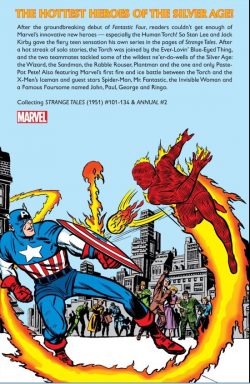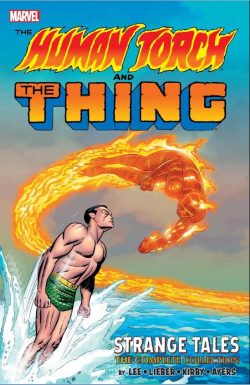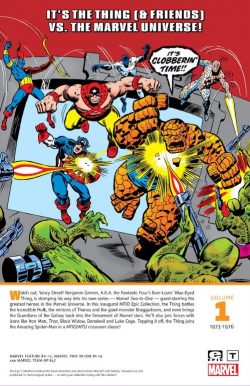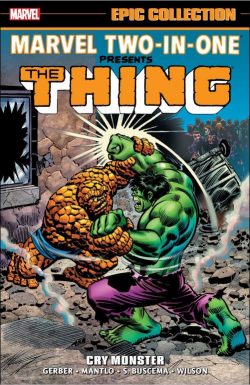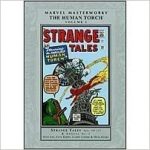
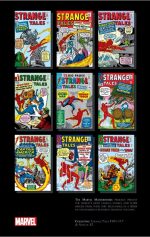
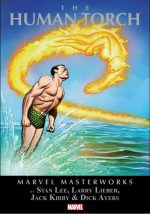
By Stan Lee & Jack Kirby, Larry Lieber, Robert Bernstein, Ernie Hart, Jerry Siegel, Dick Ayers & various (Marvel)
ISBN: 978-0-7851-2070-4 (HB) 978-0-7851-8781-3 (TPB)
Win’s Christmas Gift Recommendation: Timeless Superhero Entertainment… 9/10
Hot on the heels of the stunning success of Fantastic Four, Stan Lee & Jack Kirby spun the most colourful and youngest member of the team into his own series, hoping to recapture the glory of the 1940s when the Human Torch was one of the company’s “Big Three†superstars.
This captivating, esoteric and joyously exuberant collection of pure 1960s superhero shenanigans gathers those eclectic but crucial yarns – no less than five major Marvel villains debuted in blistering battle against the Flaming Kid – from Strange Tales #101 to 117, as well as the bombastic lead tale from Strange Tales Annual #2 (spanning October 1962 through February 1964) and comes with a fantastically informative Introduction from artist/inker Dick Ayers before all the hot action kicks off…
Filled with fabulous classics of old school Marvel Fights ‘n’ Tights mayhem and mirth, this particular compendium (available in scarce but sturdy Hardback, reassuring trade paperback and assorted eBook formats) is a perfect antidote to angst overload.
Within a year of FF #1, the magic-&-monsters anthology title Strange Tales became the home for our hot-headed hero as issue #101 saw mostly-typical teenager Johnny Storm started an ancillary solo career in the eponymous ‘The Human Torch’.
Scripted by Larry Lieber (over a plot by his brother Stan) and spectacularly illustrated by Jack Kirby & Dick Ayers, the plucky lad here investigates sabotage at a new seaside amusement park and promptly discovers Commie-conniving, thanks to a Red spy called the Destroyer. Starting a recurring pattern, Kirby would pencil the first few adventures before moving on, after which inker Ayers assumed control of the series’ look for most of its run – although The King would generate some of the best covers of his Marvel career throughout the Torch’s tenure in Strange Tales.
An odd inconsistency or, more likely, tension and drama-inducing gimmick did crop up here. Although public figures in the Fantastic Four, Johnny and his sister Sue live part-time in the Long Island hamlet of Glenville and, despite the townsfolk being fully aware of her as the glamorous and heroic Invisible Girl, they seem communally oblivious to the fact that her baby brother is the equally famous Torch.
Many daft-but-ingenious pages of Johnny protecting his secret identity would ensue before the situation was brilliantly resolved…
Although something of a hit-or-miss proposition in itself, the strip was – as previously mentioned – the starting point for many of Marvel’s best bad-guys. The first of these appeared in the very next issue. ‘Prisoner of the Wizard’ (Lee, Lieber, Kirby & Ayers) sees a spiteful, publicity-hungry intellectual giant determined to crush the Torch to prove his superiority to the callow kid who steals all the newspaper headlines…
The same creative team then produced Sci Fi captivating classic ‘Prisoner of the 5th Dimension’, wherein Johnny defeats an imminent invasion and frees a captive populace from tyranny before a month later easily trashing adhesive-toting adversary ‘Paste-Pot Pete!’ (later revamped as the terrifying Trapster). He then teams with sister Sue to tackle the perilous ‘Return of the Wizard’.
When Kirby moved on to engineer and design a host of fresh characters and concepts (occasionally returning as necessity or special events warranted), Ayers assumed full art duties with Strange Tales #106 (March 1963). This Lee & Lieber yarn was notable in that it revealed that the entire town of Glenville had always known the Torch’s secret identity, but were just playing along to keep him happy…
When Carl Zante AKA the Acrobat knocks on Johnny’s door and offers him a better-paying gig in ‘The Threat of the Torrid Twosome’, the kid’s head is swelled and swayed, but he soon learns he’s been played by a master conman and diabolical bandit…
This first hint of tongue-in-cheek whimsy presaged an increasing lightness of touch which would come to characterise the Marvel style as much as the infighting between team-mates. The villainous Zante would return for another milestone in issue #114…
Issue #107 was Lieber’s last, and Ayers drew a splendid punch-up with the ‘Sub-Mariner’ – a tale reminiscent of the spectacular and immensely popular Golden Age battles of their publishing forebears. Veteran writer Robert “Berns†Bernstein scripted the next two – frankly daft – sagas over Lee’s plots, but the saving grace of both ‘The Painter of a Thousand Perils!’ (empowered by an alien art kit which brought illustrations to life in ST #108) and ‘The Sorcerer and Pandora’s Box’ (#109, with monstrous demons attacking humanity) was the brief return of Kirby as penciller.
H.E. Huntley (Ernie Hart) typed the words for Ayers to illumine in ‘The Human Torch vs. the Wizard and Paste-Pot Pete!’: a cunning clash presaging the villains’ eventual evolution into FF’s evil counterparts the Frightful Four.
In #111 the Torch made short work of ‘Fighting to the Death with the Asbestos Man!’ – yet another demented scientist experiencing the travails and tragedies of simpler times.
Strange Tales #112 (scripted by Jerry Siegel under pen-name Joe Carter) introduced murderous electrical marauder the Eel, who accidentally swiped and activated a miniature A-Bomb in tense, multifaceted thriller ‘The Human Torch Faces the Threat of the Living Bomb!‘, after which1963’s Strange Tales Annual #2, featured ‘The Human Torch on the Trail of the Amazing Spider-Man!’
This terrific romp from Lee, Kirby & Steve Ditko details how the wallcrawler is framed by international art thief The Fox, whilst back in regular comic book Strange Tales #113, “Carter†created another long-term, always-employed villain in ‘The Coming of the Plantman!’
November’s Strange Tales #114 then changed the face of the Marvel Firmament forever…
Written by Lee himself and illustrated by Kirby & Ayers, it featured the return of the third of Timely Comics’ Golden Age Big Three – or at least an impersonation of him by the insidious Acrobat – in a blockbusting battle entitled ‘The Human Torch meets…Captain America!
Here’s a quote from the last panel…
“You guessed it! This story was really a test! To see if you too would like Captain America to Return! As usual, your letters will give us the answer!†I wonder how that all turned out?
Lee took over as full scripter with ST #115’s ‘The Sandman Strikes!’, wherein Johnny impersonates Spider-Man to defeat granular gangster Flint Marko, after which the Torrid Teen and team-mate Ben Grimm battle each other while ‘In the Clutches of the Puppet Master!’ (#116, with Ayers inked by George Roussos in his own secret identity of George Bell).
Ending this initial offering with #117, ‘The Return of the Eel! sees the vengeful reprobate prove far more of a challenge this time, thanks to some careful planning and Johnny’s own impetuosity…
Wrapping up this memory lane meander are some rousing house ads and a marvellous gallery of original art pages from Ayers.
It’s interesting to note that as the parent Fantastic Four title grew in scope and quality the Human Torch’s own series diminished. Perhaps there is something to be said for concentrating one’s efforts or not overexposing your stars. What was originally a spin-off for the younger audience faded as Marvel found its voice and its marketplace, although there would be periodic efforts to reinvigorate the Torch.
Sadly, the historic value sometimes supersedes the quality of these strange tales, but there’s still a great deal to enjoy about this series and Costumed Drama devotees with a sense of tradition and love of fun will find this book irresistible and unmissable.
© 2020 MARVEL

